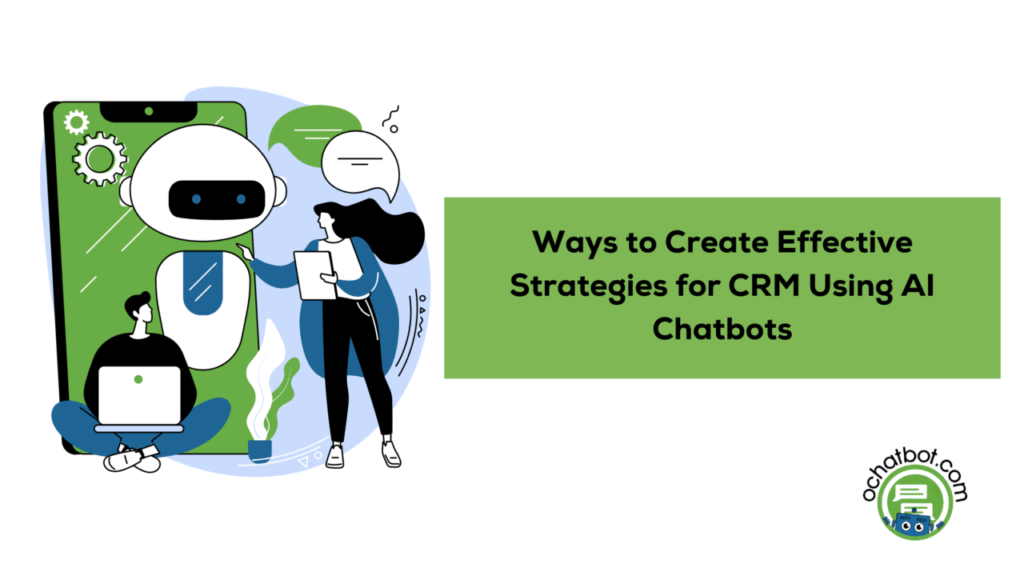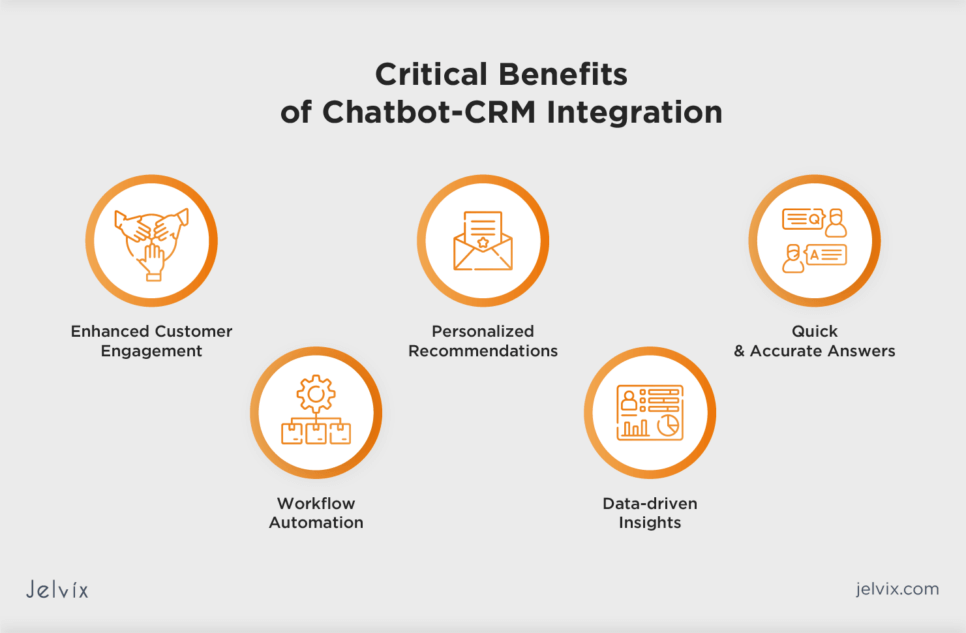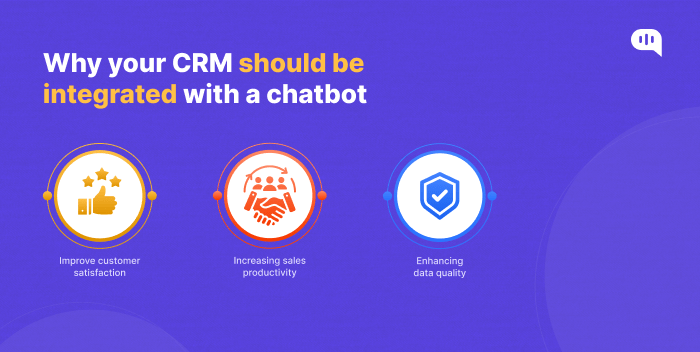
Supercharge Your Marketing: The Ultimate Guide to CRM and Chatbot Integration
In today’s fast-paced digital landscape, businesses are constantly seeking innovative ways to connect with their customers, streamline operations, and boost their bottom line. One of the most powerful combinations emerging in the marketing world is the integration of Customer Relationship Management (CRM) systems and chatbots. This dynamic duo offers a wealth of benefits, from improved customer service and lead generation to enhanced sales and marketing automation. This comprehensive guide will delve into the intricacies of CRM and chatbot integration, providing you with the knowledge and insights you need to leverage this powerful technology for your business.
Understanding the Power of CRM and Chatbots
Before we dive into the how-to’s, let’s take a moment to appreciate the individual strengths of CRM systems and chatbots. Then, we’ll explore how their combined power can revolutionize your marketing efforts.
What is a CRM?
A Customer Relationship Management (CRM) system is essentially a central hub for all your customer data. It’s a database that stores information about your leads, prospects, and existing customers, including their contact details, purchase history, communication logs, and more. Think of it as the brain of your customer interactions. A good CRM system helps you:
- Organize Customer Data: Keep all customer information in one place, making it easily accessible to your team.
- Improve Customer Relationships: Understand customer needs and preferences to personalize interactions.
- Automate Tasks: Automate repetitive tasks like sending emails and scheduling appointments.
- Track Sales Performance: Monitor sales progress, identify trends, and optimize your sales strategies.
- Enhance Collaboration: Enable seamless communication and collaboration between sales, marketing, and customer service teams.
Popular CRM systems include Salesforce, HubSpot, Zoho CRM, and Microsoft Dynamics 365, among others. Choosing the right CRM for your business depends on your specific needs, budget, and the size of your organization.
What is a Chatbot?
A chatbot is a computer program designed to simulate conversation with human users, especially over the Internet. Chatbots can be deployed on websites, messaging apps like Facebook Messenger and WhatsApp, and even within your CRM system. They use natural language processing (NLP) and machine learning (ML) to understand user queries and provide relevant responses. Chatbots are available 24/7, providing instant support and information to your customers. They can handle a wide range of tasks, including:
- Answering Frequently Asked Questions (FAQs): Provide instant answers to common customer inquiries.
- Qualifying Leads: Gather information about potential customers and identify those who are most likely to convert.
- Scheduling Appointments: Allow customers to book appointments directly through the chatbot.
- Providing Customer Support: Offer basic troubleshooting and direct customers to the right resources.
- Collecting Feedback: Gather customer feedback through surveys and questionnaires.
Some popular chatbot platforms include ManyChat, Chatfuel, Dialogflow (Google), and Microsoft Bot Framework. The best chatbot platform for you will depend on your specific needs and technical expertise.
The Synergy: CRM and Chatbots Working Together
The true magic happens when you integrate your CRM system with a chatbot. This integration allows you to combine the power of organized customer data with the instant responsiveness of a chatbot. Here’s how they work together:
- Personalized Interactions: The chatbot can access customer data from the CRM to personalize conversations and provide tailored recommendations.
- Automated Lead Qualification: Chatbots can qualify leads by asking relevant questions and automatically updating the CRM with the collected information.
- Improved Customer Service: Chatbots can provide instant answers to common questions and escalate complex issues to human agents, all while providing context from the CRM.
- Enhanced Sales Processes: Chatbots can guide potential customers through the sales process, answer their questions, and schedule demos or consultations.
- Data-Driven Insights: The integration allows you to track chatbot interactions and analyze the data to gain valuable insights into customer behavior and preferences.
Key Benefits of CRM and Chatbot Integration
Integrating your CRM and chatbot offers a plethora of advantages for businesses of all sizes. Here are some of the most significant benefits:
1. Enhanced Customer Experience
A seamless customer experience is crucial for building brand loyalty and driving repeat business. CRM and chatbot integration can significantly enhance the customer experience in several ways:
- 24/7 Availability: Chatbots are available around the clock, providing instant support and answering customer questions at any time of day or night.
- Personalized Interactions: Chatbots can access customer data from the CRM to personalize conversations and provide tailored recommendations, making customers feel valued and understood.
- Faster Response Times: Chatbots can provide instant answers to common questions, reducing wait times and improving customer satisfaction.
- Consistent Communication: Chatbots ensure consistent messaging across all channels, reinforcing your brand identity and values.
2. Increased Lead Generation and Qualification
Generating and qualifying leads is a crucial part of the sales process. CRM and chatbot integration can help you automate and optimize your lead generation efforts:
- Lead Capture: Chatbots can be deployed on your website or social media platforms to capture leads by asking for contact information and gathering relevant details.
- Lead Qualification: Chatbots can qualify leads by asking a series of questions to determine their needs, budget, and timeline.
- Automated Lead Scoring: Chatbots can automatically score leads based on their responses, allowing you to prioritize the most promising prospects.
- Seamless Hand-offs: Chatbots can seamlessly hand off qualified leads to your sales team, providing them with all the necessary information to close the deal.
3. Improved Sales and Marketing Automation
Automation is key to streamlining your sales and marketing processes, saving time, and improving efficiency. CRM and chatbot integration can automate a variety of tasks:
- Automated Email Marketing: Chatbots can collect email addresses and preferences, triggering automated email campaigns based on customer behavior.
- Appointment Scheduling: Chatbots can allow customers to book appointments directly through the chatbot, eliminating the need for manual scheduling.
- Personalized Product Recommendations: Chatbots can recommend products or services based on customer data and preferences.
- Targeted Content Delivery: Chatbots can deliver targeted content based on customer behavior and interests.
4. Reduced Customer Service Costs
By automating customer service tasks, CRM and chatbot integration can help you reduce your customer service costs:
- Reduced Agent Workload: Chatbots can handle a large volume of customer inquiries, freeing up human agents to focus on more complex issues.
- Faster Issue Resolution: Chatbots can provide instant answers to common questions, resolving issues faster and reducing the need for human intervention.
- Improved Agent Productivity: By providing agents with access to customer data and conversation history, the integration can improve agent productivity and efficiency.
- Lower Training Costs: Chatbots can handle basic customer service tasks, reducing the need for extensive training for human agents.
5. Data-Driven Insights and Reporting
CRM and chatbot integration provides valuable data-driven insights that can help you understand your customers and optimize your marketing efforts:
- Track Chatbot Interactions: Track chatbot interactions to understand customer behavior, identify common pain points, and measure chatbot performance.
- Analyze Customer Data: Analyze customer data to identify trends, personalize interactions, and improve your marketing strategies.
- Generate Reports: Generate reports to track key metrics such as lead generation, sales conversions, and customer satisfaction.
- Optimize Marketing Campaigns: Use the insights from the integration to optimize your marketing campaigns and improve your ROI.
How to Integrate Your CRM and Chatbot
Integrating your CRM and chatbot can seem daunting, but the process is usually straightforward. Here’s a general overview of the steps involved:
1. Choose the Right CRM and Chatbot Platforms
The first step is to choose the right CRM and chatbot platforms for your business. Consider your specific needs, budget, and technical expertise. Research different platforms and compare their features, pricing, and integration capabilities. Make sure the CRM and chatbot platforms you choose are compatible and offer seamless integration options.
2. Define Your Goals and Objectives
Before you start integrating, define your goals and objectives. What do you want to achieve with the integration? Are you looking to improve customer service, generate more leads, or automate sales processes? Having clear goals will help you design your integration strategy and measure your success.
3. Plan Your Integration Strategy
Plan how you will integrate your CRM and chatbot. Consider the following:
- Data Mapping: Determine which data fields from your CRM will be accessible to the chatbot.
- Conversation Flows: Design the conversation flows for your chatbot, including the questions it will ask, the information it will collect, and the actions it will take.
- Integration Method: Decide how you will integrate the two systems. You can use a native integration (if available), a third-party integration platform, or custom development.
4. Configure Your CRM and Chatbot
Configure your CRM and chatbot to support the integration. This may involve setting up user permissions, creating custom fields, and configuring API keys. Follow the documentation provided by your CRM and chatbot platforms to ensure a smooth setup.
5. Test and Refine
Thoroughly test your integration to ensure it’s working as expected. Test the conversation flows, data transfer, and any automated actions. Make adjustments as needed to improve the user experience and ensure the integration is functioning optimally. Continuously monitor and refine your integration based on performance and customer feedback.
6. Consider Third-Party Integration Platforms
If your CRM and chatbot platforms do not offer native integration, or if you require more advanced features, consider using a third-party integration platform. These platforms often provide pre-built connectors and workflows that simplify the integration process. Some popular integration platforms include Zapier, Integromat (Make), and Tray.io.
Best Practices for CRM and Chatbot Integration
To ensure a successful CRM and chatbot integration, consider these best practices:
1. Start Small and Iterate
Don’t try to do everything at once. Start with a simple integration that addresses a specific pain point or objective. Once you’ve successfully implemented the initial integration, you can gradually add more features and functionality. This iterative approach allows you to learn from your experiences and make adjustments as needed.
2. Prioritize User Experience
The user experience should be at the forefront of your integration strategy. Design your chatbot conversations to be natural, intuitive, and engaging. Make sure the chatbot provides helpful and relevant information, and that it seamlessly integrates with your CRM. Test your chatbot thoroughly to ensure it provides a positive user experience.
3. Personalize the Experience
Leverage the customer data in your CRM to personalize the chatbot experience. Greet customers by name, provide tailored recommendations, and offer relevant information based on their past interactions. Personalization can significantly improve customer satisfaction and engagement.
4. Provide Seamless Hand-offs to Human Agents
While chatbots are great for handling basic inquiries, they are not always able to resolve complex issues. Make sure your chatbot can seamlessly hand off conversations to human agents when necessary. Provide the human agent with access to the chatbot conversation history and CRM data to ensure a smooth transition.
5. Train Your Chatbot Regularly
Natural language processing (NLP) and machine learning (ML) are constantly evolving. Train your chatbot regularly to improve its accuracy and understanding. Review chatbot interactions and identify areas for improvement. Update your chatbot’s knowledge base with new information and train it to handle new types of inquiries.
6. Monitor and Measure Performance
Continuously monitor and measure the performance of your CRM and chatbot integration. Track key metrics such as lead generation, sales conversions, customer satisfaction, and chatbot usage. Use this data to identify areas for improvement and optimize your integration strategy.
7. Ensure Data Privacy and Security
Protecting customer data is essential. Ensure your CRM and chatbot platforms comply with all relevant data privacy regulations, such as GDPR and CCPA. Implement security measures to protect customer data from unauthorized access and breaches. Be transparent with your customers about how you use their data.
Examples of Successful CRM and Chatbot Integration
Let’s look at some real-world examples of how businesses are successfully using CRM and chatbot integration:
1. E-commerce:
An e-commerce business integrates its CRM with a chatbot to provide instant customer support. The chatbot answers FAQs, tracks order status, and provides personalized product recommendations based on customer purchase history stored in the CRM. This integration has resulted in increased customer satisfaction and sales.
2. Healthcare:
A healthcare provider integrates its CRM with a chatbot to schedule appointments and answer patient inquiries. The chatbot accesses patient data from the CRM to personalize the experience and provide relevant information. This has reduced the workload on administrative staff and improved patient satisfaction.
3. Real Estate:
A real estate agency integrates its CRM with a chatbot to generate leads and qualify prospects. The chatbot asks questions about the prospect’s needs and preferences and automatically updates the CRM with the information. This has helped the agency identify and prioritize the most promising leads, leading to more sales.
4. Financial Services:
A financial institution integrates its CRM with a chatbot to provide customer support and answer questions about accounts and services. The chatbot accesses customer data from the CRM to personalize the experience and provide relevant information. This has improved customer satisfaction and reduced the workload on customer service representatives.
The Future of CRM and Chatbot Integration
The integration of CRM systems and chatbots is still in its early stages, and the potential for growth and innovation is enormous. As artificial intelligence (AI) and machine learning (ML) continue to evolve, we can expect to see even more sophisticated and powerful integrations in the future.
Here are some trends to watch:
- More Advanced AI: Chatbots will become even more intelligent and capable of handling complex inquiries and providing personalized recommendations.
- Improved Natural Language Processing: Chatbots will become better at understanding human language and providing natural and engaging conversations.
- Integration with More Channels: Chatbots will be integrated with more channels, including voice assistants, social media platforms, and in-app messaging.
- Proactive Customer Service: Chatbots will proactively reach out to customers with relevant information and offers.
- Predictive Analytics: Chatbots will use predictive analytics to anticipate customer needs and provide proactive support.
The future of CRM and chatbot integration is bright. Businesses that embrace this technology will be well-positioned to enhance customer experiences, streamline operations, and drive growth.
Conclusion
CRM and chatbot integration is a powerful combination that can revolutionize your marketing efforts. By integrating these two technologies, you can enhance customer experiences, generate more leads, automate sales processes, reduce customer service costs, and gain valuable data-driven insights. By following the best practices outlined in this guide, you can successfully integrate your CRM and chatbot and reap the many benefits of this powerful technology. The time to embrace CRM and chatbot integration is now. Take the first step today and see how it can transform your business!


